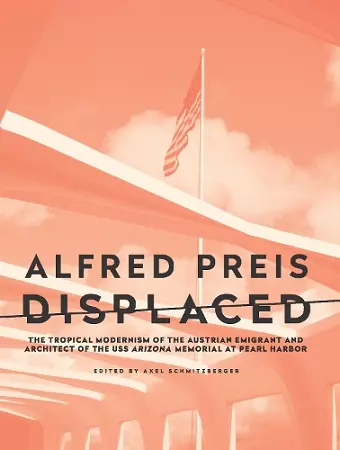Alfred Preis Displaced
The Tropical Modernism of the Austrian Emigrant and Architect of the USS Arizona Memorial at Pearl Harbor
Stephen Phillips author Christopher Long author August Sarnitz author Axel Schmitzberger author Laura McGuire author
Format:Paperback
Publisher:DoppelHouse Press
Published:3rd Nov '22
Currently unavailable, our supplier has not provided us a restock date

- 2022 is the 60th anniversary of the USS Arizona Memorial
- Pacific Historic Parks is copublisher and exclusive retailer for the Hawaiian Islands
- Contributions from leading architectural scholars
- Targeted outreach to art and architecture bookstores and libraries
- Unique cover by award-winning designer appeals to art magazines and bookstores
- Promotion through the Society of Architectural Historians/Southern California Chapter
- DRCs available through Edelweiss
- ARCs available
The first publication to catalog the complete works of architect and arts advocate Alfred Preis, a Viennese modernist who fled Nazi-occupied Austria and transformed regional Hawaiian architecture, with his best-known project being the USS Arizona Memorial at Pearl Harbor.
Architect, planner, and arts advocate Alfred Preis (1911–1994) dedicated his many creative talents to his beloved, adopted home, Hawai‘i. Born to a Jewish family, raised, and educated in Vienna, Preis became an exile after escaping from Nazi-occupied Austria in 1939 and briefly being interned as an “enemy alien” when the United States entered World War II. Preis emerged as one of Hawai‘i’s leading modern architects in the 1950s and 1960s. His celebrated architectural career spanned twenty-three years. In this time, he designed almost one hundred and eighty completed projects ranging from residences, schools, commercial buildings, and public parks. His new, regionalist vision for architecture and planning were specific to the Hawaiian context, its people, its tropical climate, and its stunning landscape. Preis’s crowning achievement was his design for the famed USS Arizona Memorial at Pearl Harbor in 1962.
This is the first publication to examine Alfred Preis’s body of work in architecture, which spans from 1939 to 1963, including not only several acclaimed public projects but also illustrating the transition from a European modern language into a regional modernism, unifying both cultures in distinct and pioneering ways.
In later years through his legislative work, Alfred Preis became a visionary advocate and leader for the public arts, creating the first 1% law in the United States, which stipulated that 1% of all public building construction be used for the purchase of public art.
On May 30, 1962, the USS Arizona Memorial was officially dedicated. The white concrete and steel structure is 184 feet (56 metres) long and spans the wreckage. It was designed by Alfred Preis, an Austrian-born architect who was sent to a U.S. internment camp after the Pearl Harbor attack. His simple design features a concave silhouette, with the middle representing the country’s low point following the attack and the raised ends symbolizing victory. The 21 open-air windows are said to reference a 21-gun salute. In 1980 oversight of the memorial was transferred to the National Park Service. Approximately 1.8 million people visit the memorial each year.
—Brittanica.com
Preis is best known for his design of the USS Arizona Memorial at Pearl Harbor, though he worked extensively on residences, schools, and parks in Honolulu and O’ahu. Preis was pragmatic, client-oriented, and a modernist with training in the holistic principles of Wagner and Loos that he understood and adopted. Over the years, he would shift to a regional modernism.
—Architects+Artisans
The first major effort to this date to bring the Austrian-American architect back into the international spotlight by capturing, illustrating, and contextualizing the wide spectrum and influence of his prolific architectural and advocacy work. With his architecture as central focus, [Alfred Preis Displaced] seeks an opportunity to highlight Preis’s built work to a larger audience and acknowledge the bi-cultural exchange between Austria and the US state of Hawai‘i.
—ArtFix Daily
Committed to progressive racial and social causes in the islands’ political and social spheres [...] Preis articulated the value of locally-sourced materials and examples of his work include how the islands coped with material shortages after the war. He also constructed hundreds of homes for low-to-middle-income state residents, defining himself as an architect not for the elite, but as a designer for the people of Hawaiʻi.
—University of Hawai‘i News
Preis — who fled Nazi-occupied Austria in 1939 and two years later was forced into internment with Japanese and German nationals at the Sand Island Detainment Camp — built some of the Hawai‘i's most enduring structures and institutions. He designed the USS Arizona Memorial in Pearl Harbor and founded the Hawai‘i State Foundation for Culture and Arts, serving as executive director from 1966-1980.
—On the Grid, newsletter of CalPoly Pomona, College of Environmental Design
ISBN: 9781954600140
Dimensions: 241mm x 190mm x 25mm
Weight: unknown
256 pages